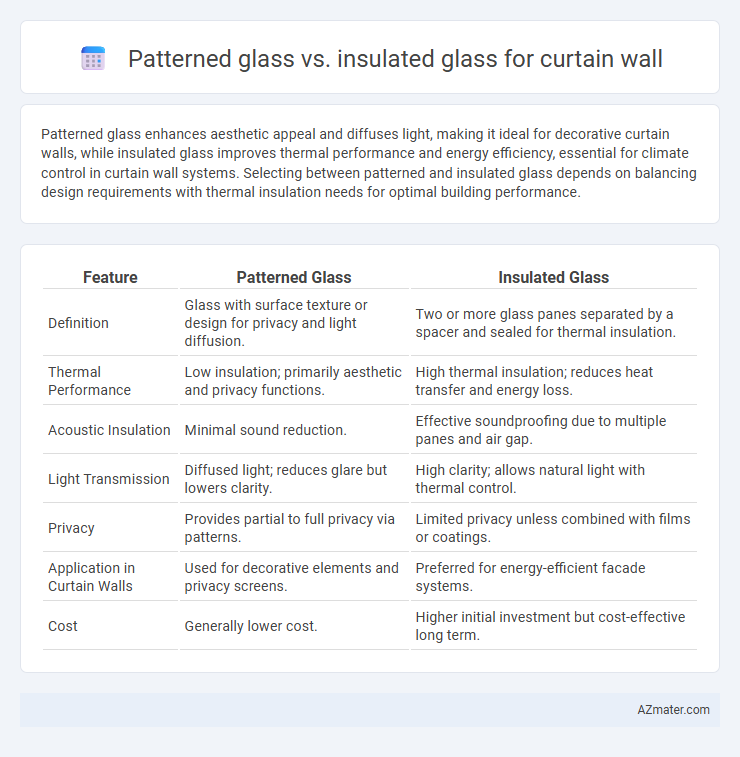Patterned glass enhances aesthetic appeal and diffuses light, making it ideal for decorative curtain walls, while insulated glass improves thermal performance and energy efficiency, essential for climate control in curtain wall systems. Selecting between patterned and insulated glass depends on balancing design requirements with thermal insulation needs for optimal building performance.
Table of Comparison
| Feature | Patterned Glass | Insulated Glass |
|---|---|---|
| Definition | Glass with surface texture or design for privacy and light diffusion. | Two or more glass panes separated by a spacer and sealed for thermal insulation. |
| Thermal Performance | Low insulation; primarily aesthetic and privacy functions. | High thermal insulation; reduces heat transfer and energy loss. |
| Acoustic Insulation | Minimal sound reduction. | Effective soundproofing due to multiple panes and air gap. |
| Light Transmission | Diffused light; reduces glare but lowers clarity. | High clarity; allows natural light with thermal control. |
| Privacy | Provides partial to full privacy via patterns. | Limited privacy unless combined with films or coatings. |
| Application in Curtain Walls | Used for decorative elements and privacy screens. | Preferred for energy-efficient facade systems. |
| Cost | Generally lower cost. | Higher initial investment but cost-effective long term. |
Introduction to Curtain Wall Glazing Options
Patterned glass offers decorative texture and enhanced privacy for curtain wall glazing, making it ideal for aesthetic applications and glare reduction. Insulated glass combines two or more glass panes with an air or gas-filled space, providing superior thermal performance and energy efficiency in curtain walls. Choosing between patterned and insulated glass depends on balancing design preferences with thermal insulation requirements in building envelopes.
What is Patterned Glass?
Patterned glass is a type of textured glass with surface designs that enhance privacy and diffuse light while maintaining visibility, commonly used in curtain walls to add aesthetic appeal and reduce glare. It offers unique patterns such as reeded, fluted, or hammered textures that can mask imperfections and provide architectural interest without compromising structural integrity. Unlike insulated glass, which focuses on thermal performance by combining multiple glass panes with a spacer, patterned glass primarily addresses visual effects and interior light quality in building facades.
What is Insulated Glass?
Insulated glass, also known as double glazing, consists of two or more glass panes separated by a spacer filled with air or inert gas, significantly improving thermal performance and sound insulation in curtain wall systems. Patterned glass, while offering aesthetic variation and privacy through textured surfaces, lacks the superior energy efficiency and condensation resistance provided by insulated glass. Choosing insulated glass enhances building comfort and reduces energy consumption by minimizing heat transfer in curtain wall applications.
Thermal Performance Comparison
Patterned glass offers modest thermal insulation due to its textured surface, which can diffuse light but typically lacks significant energy efficiency benefits compared to insulated glass. Insulated glass units (IGUs) feature multiple panes separated by air or gas-filled spaces, providing superior thermal performance by reducing heat transfer and improving energy conservation in curtain wall systems. The enhanced thermal resistance of insulated glass helps maintain indoor temperature stability and lowers HVAC costs, making it the preferred choice for energy-efficient building envelopes.
Light Transmission and Privacy
Patterned glass offers varied light transmission through textured surfaces, diffusing natural light and enhancing privacy by obscuring visibility, making it ideal for areas requiring moderate brightness and visual screening in curtain walls. Insulated glass, typically composed of double or triple glazing with air or gas fill, maximizes light transmission efficiency while improving thermal performance but provides less inherent privacy compared to patterned glass. Choosing between patterned and insulated glass depends on balancing daylight penetration needs with privacy goals in curtain wall design.
Acoustic Insulation Differences
Patterned glass typically provides limited acoustic insulation due to its single-pane construction, allowing more sound transmission through curtain walls. Insulated glass units (IGUs), comprising two or more glass panes separated by an air or gas-filled space, significantly enhance soundproofing by dampening noise vibrations. For curtain walls requiring superior acoustic performance, insulated glass outperforms patterned glass by reducing external noise infiltration and improving indoor sound comfort.
Aesthetic and Design Flexibility
Patterned glass offers unique textures and visual effects, enhancing the aesthetic appeal of curtain walls while providing privacy through diffused light transmission. Insulated glass improves thermal performance and sound insulation without compromising transparency, allowing designers to maintain sleek, modern appearances. Combining both technologies can optimize design flexibility by balancing decorative patterns with energy efficiency in curtain wall systems.
Energy Efficiency Considerations
Patterned glass in curtain walls offers light diffusion and privacy but generally provides lower thermal insulation compared to insulated glass, which features multiple panes separated by gas fills or coatings to reduce heat transfer. Insulated glass significantly improves energy efficiency by minimizing heat loss in winter and heat gain in summer, contributing to lower HVAC costs and enhanced occupant comfort. Selecting insulated glass with low-emissivity coatings further optimizes energy performance in curtain wall applications.
Cost Implications and Installation
Patterned glass typically incurs lower material costs compared to insulated glass, making it a budget-friendly option for curtain wall applications. Insulated glass, composed of two or more glass panes separated by a spacer and sealed, offers superior thermal performance but requires more complex installation processes and specialized sealing techniques. The increased labor and equipment demands for insulated glass installation can raise overall project expenses despite its long-term energy savings benefits.
Best Applications: Patterned vs Insulated Glass
Patterned glass is ideal for privacy and decorative purposes in curtain walls, offering light diffusion while obscuring visibility, making it suitable for office partitions or retail storefronts. Insulated glass provides superior thermal performance and energy efficiency, essential for curtain walls in climates with extreme temperatures or for buildings aiming to meet green building standards. Choosing between patterned and insulated glass depends on whether the priority is aesthetic enhancement and privacy or maximizing insulation and energy savings.

Infographic: Patterned glass vs Insulated glass for Curtain wall
 azmater.com
azmater.com